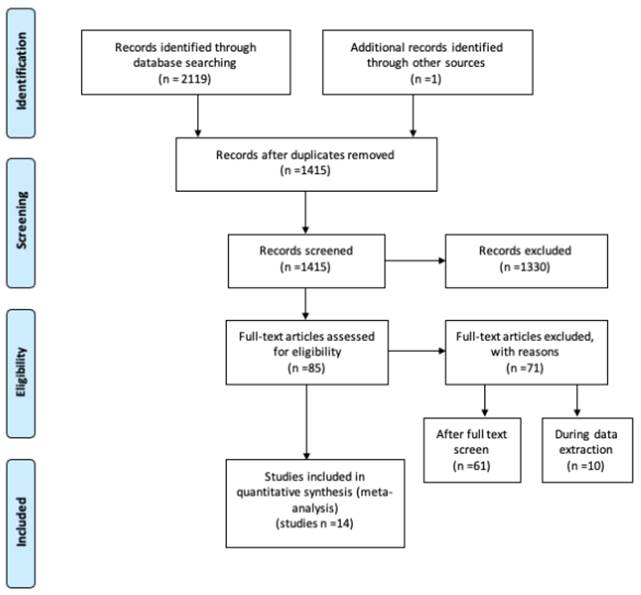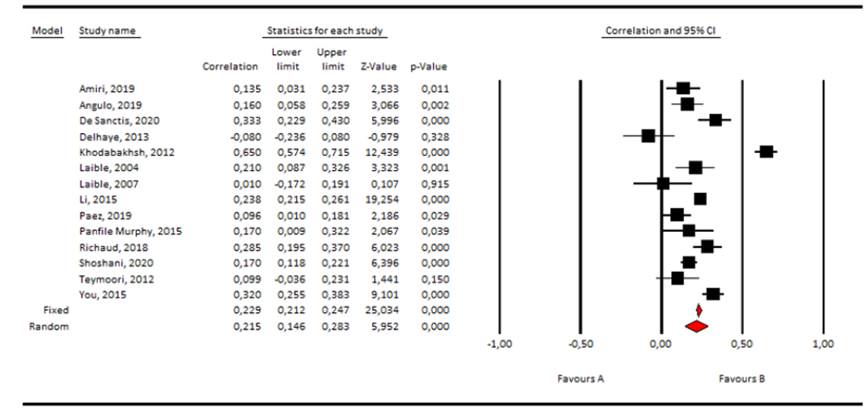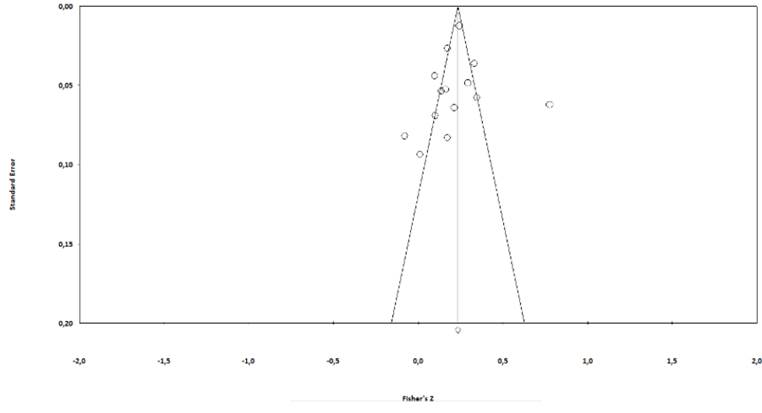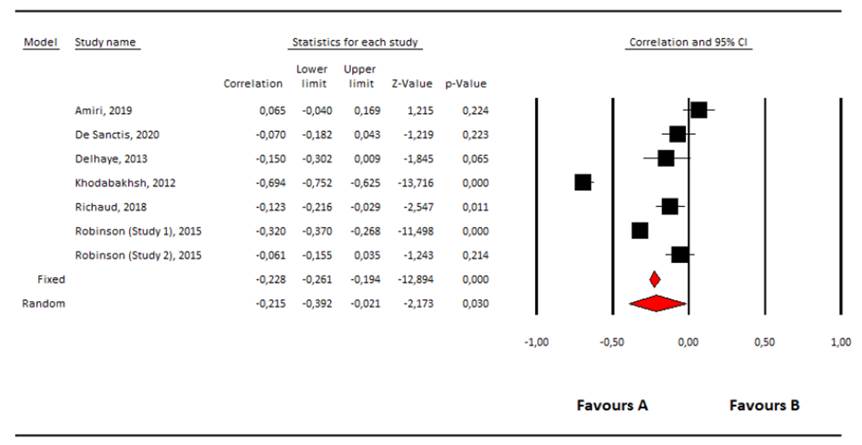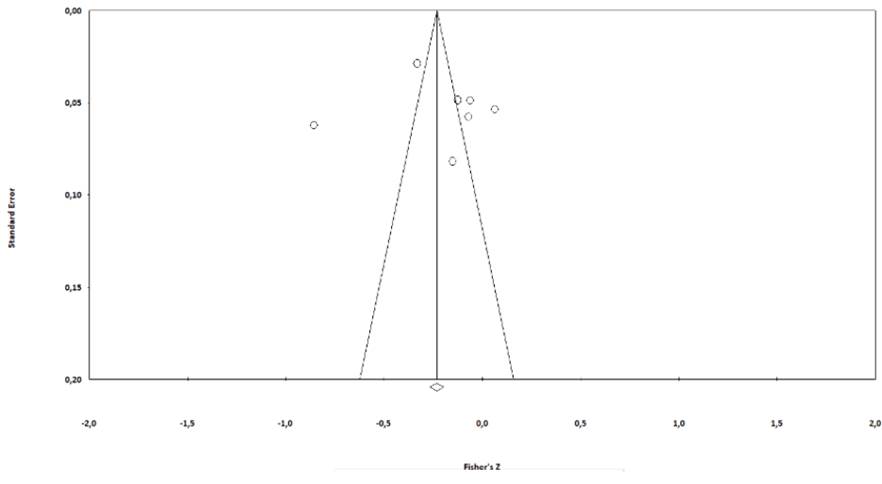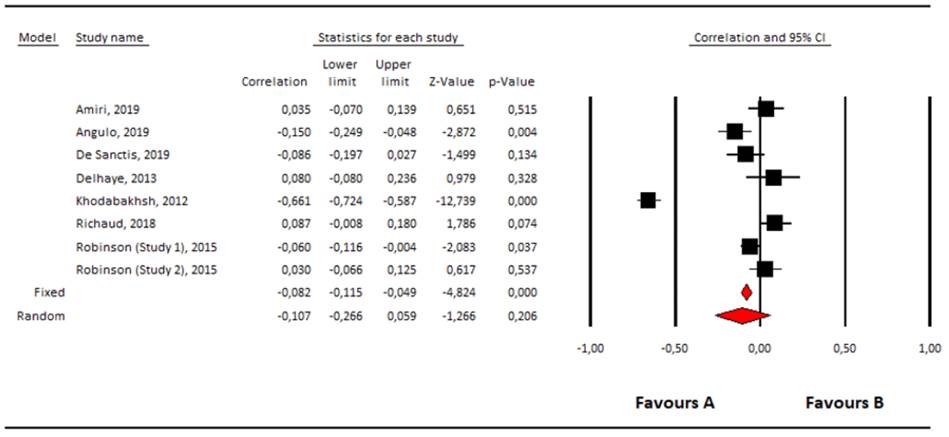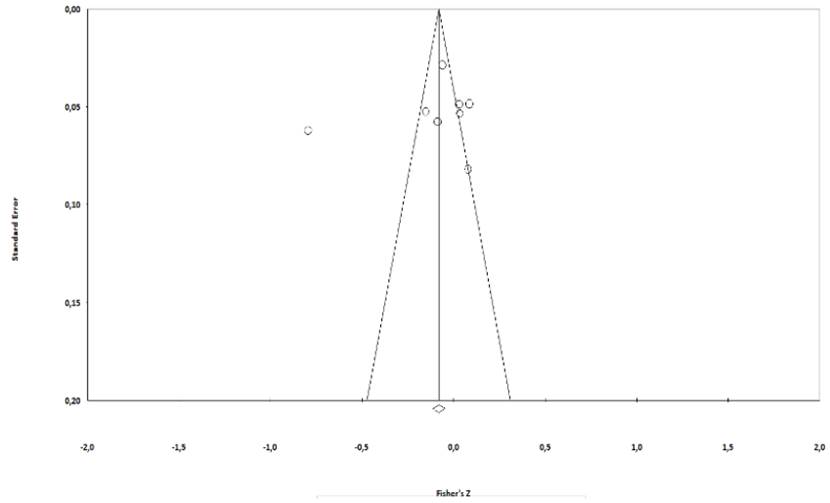1. introduction
Attachment representations have a fundamental role in the development of different social skills, in particular empathy, which helps people to interact with others and prevent aggressive behaviors. It is believed that having a secure attachment can promote empathy. However, there is no clear evidence about the relationship between the insecure attachment styles and empathy. For example, some studies have shown that anxious-ambivalent adolescents’ attachment style has a negative relationship with empathy (Khodabakhsh, 2012), while others have shown a non-significant relation to empathy (Delhaye, 2013) or even a positive relation (Amiri, 2019). The same goes with avoidant attachment, as some studies have shown a negative relationship with empathy (Khodabakhsh, 2012) while others have shown non-significant relation to empathy (Goldstein & Higgins-D’Alessandro, 2001). Therefore, inconsistent results whenever analyzing the relationship between attachment styles and empathy may be due to the several dimensions that are involved in the concept of emotional empathy. The aim of this study is to do a meta-analytic review on the relationship of different types of attachments with empathy to clarify this relation. For this research, studies on late children, adolescents, and adults were considered with ages ranging from 9 to 47 years old.
1.1 Attachment
The concept of attachment has been conceptualized in different ways, such as a strong affectional bond between a child and its caregiver (Ainsworth, 1989), or as a behavior in children that consists of seeking proximity to a protective figure (Bowlby, 1969). In adolescence and adulthood, the concept of attachment refers to the current accounts of the past experiences with their caregivers (Delhaye, 2013). Following the behavioral conception of attachment proposed by Bowlby (1969), there are two complementary behavioral systems that have evolved in order to get survival for humans across all times. The first behavioral system is the attachment system, in which a person seeks for proximity, expressing their needs and discomfort. This system gets activated in times of vulnerability, during long periods of helplessness (Ainsworth et al., 2015). The second behavioral system is the caregiving provided, usually from the mother or the main caregiver, which responds to the signals of distress in the child and provides comfort and care for the child. These dynamic relations between the two systems result in a physiological regulation and security sense in the relationship (Stern & Cassidy, 2018).
The primary experiences of this interplay between the two systems, in which the child feels discomfort and expresses distress, and the caregiver provides -or not- care, start to develop in the child the internal representations of attachment relations with the caregiver. These representations function as a prototype for later relationships in life. Bowlby (1973) stated that two key features are identified in these internal representations or working models. One is the self-image, established when the self is judged to be a person towards the attachment figure is likely -or not- to respond in a helpful way. On the other hand, there is the image of others, which is derived from the judgment of attachment figures as being responsible and protective.
These internal working models of attachment are the core components of relationships with others, because having a positive or negative image of the self and others will impact directly in the quality of the interaction with other people and in the social skills. Stern and Cassidy (2018) suggest that consistent and sensitive caring fosters secure internal working models in the child and inconsistent and insensitive caring will shape insecure mental representations.
Based on these behavioral attachment systems developed in childhood, different types of attachment patterns present across the lifespan have been described and measured.
1.2. Attachment Classifications and Assessment
Since the concept of attachment has evolved through many years and has been largely studied by many researchers and theoreticians over the last sixty years, a wide variety of attachment classifications and instruments have been developed (Jewell et al., 2019).
The first classification of attachment by Ainsworth categorized attachment patterns tracing them from childhood to adolescence and adulthood. She started by studying the secure pattern of attachment, in which the caregiver allowed for the safe exploration of the environment during childhood. In this pattern, individuals are more able to share and express openly their feelings during adolescence and adulthood, valuing attachment relationships with their family (Ainsworth & Bell, 1970; Ainsworth et al., 1978; Main et al., 1985). The second pattern described was the avoidant pattern that for Ainsworth (1989) begins in early childhood, when the caregiver is insensitive to the needs of the infant, causing for the late adolescent or adult to not easily rely on the family and undervaluing attachment relationships. The last pattern identified by Ainsworth and Bell (1970) was the insecure anxious-ambivalent or rejecting pattern that was rooted in childhood by inconsistent levels of caregiving and followed up through adolescence and adulthood with the developing of anxiety and fear of abandonment.
Regarding the measurement of attachment, middle childhood and adolescence constitute developmental phases for which several instruments exist (Bosmans & Kerns, 2015). Two continuous self-report instruments are widely used. First, the Children’s Attachment Style Classification Questionnaire (Finzi-Dottan et al., 2012), which is aimed at children in latency age and follows Ainsworth’s 1969) attachment style classification. Another measure for latency age children is the Kerns Security Scale (Kerns et al., 1996), in which the classification of the different attachment styles is summarized in the distinction between insecure and secure attachment to the mother or the father (Kim & Kochanska, 2017). Others scales, like the Inventory of Parent and Peer Attachment (Armsden & Greenberg, 1987), also take into account the figure of attachment that can be the mother, the father or peers. This measure is used mostly for late children and adolescents and three broad dimensions are assessed: degree of mutual trust, quality of communication, and extent of anger and alienation. It classifies attachment between secure and insecure for mother, father, and peers.
Most self-report adult attachment instruments were developed focusing on romantic relationships such as the Experiences in Close Relationship Scale (ECR; Brennan et al., 1998), the Relationships Style Questionnaire (RSQ; Griffin & Bartholomew, 1994), and the Adult Attachment Questionnaire (AAQ; Simpson, 1990). These measures excluded adolescents and adults without experience in such relationships, especially those that were too young to be romantically involved. Therefore, some other self-report measures such as the Attachment Style Questionnaire (ASQ; Feeney et al., 1994) were developed to research the role of attachment processes in general, rather than in romantic or close relationships (Karantzas et al., 2010). This self-report measure was developed based on the classification of Bartholomew and Horowitz (1991), which followed the concept of internal working models of the self and others as positive or negative. Four logically derived categories emerged by the combination of these variants: secure, anxious ambivalent, dismissive avoidant (dismissing of intimacy and strongly independent), and fearful avoidant (fearful of intimacy and socially avoidant). Another self-report measure of attachment for adults based on the internal working models is the CaMir (a French acronym that stands for Cartes: Modèles individuels de relation and translates into English as Cards-Individual models of relationships) (Pierrehumbert et al., 1996), or the CaMir-R (Balluerka et al., 2011), which is a Q-sort self-report questionnaire that measures present or past attachment representations within the family. These instruments provide a continuous score of attachment (Delhaye, 2013).
In Table 1 there is a summary of attachment classifications and their assessment in terms of the available instruments according to the authors that were researched within this study.
1.3. Empathy and its Relationship with Attachment
The relationship between empathy and attachment has been examined for several decades (Teymoori & Shahrazad, 2012). Empathy has been defined as the ability to understand and share the emotional state or context of another person, and the ability to communicate this understanding (Cohen & Strayer, 1996; Kim & Kochanska, 2017). Davis (1983) makes emphasis on the reaction of an individual to the experiences of another individual. Therefore, empathy is viewed as a multidimensional construct which includes the cognitive and affective components of empathy, but also takes into account the neurobiological processes. These components seem to be shared with attachment (Ruckstaetter et al., 2017). The cognitive component of empathy involves intellectually understanding another person’s perspective, and it is a conscious process that results of taking the perspective of the other person, whereas the affective aspect of empathy is automatic, mostly unconscious and connected with the emotional resonance with another’s emotion and distress (Gladstein, 1983; Smith, 2006). The affective empathy includes the empathic concern dimension and personal distress is characterized by the tendency to experience and share the emotions of others (Teymoori & Shahrazad, 2012).
While attachment style refers to the affective bonds between people, empathy refers to the response and attention to the emotional emotions and states of others (Parcon, 2017). From the evolutionary theory perspective, both concepts have evolved together, because parents had to develop empathy, together with the caregiving system, in order to recognize and respond to the biological needs of their descendants, and provide care to ensure the survival of the species (Ruckstaetter et al., 2017). It has been argued that secure attachment with parents creates an appropriate climate at home that fosters interpersonal growth and the development of social skills like empathy (Garber et al., 1997; Kim & Kochanska, 2017; Zahn-Waxler & Radke-Yarrow, 1990).
On the other hand, regarding the avoidant attachment style, some authors found a negative relation with empathy (Boag & Carnelley, 2016; Burnette et al., 2009; Joireman et al., 2002; Kestenbaum et al., 1989; Khodabakhsh, 2012; Wayment, 2006), because this attachment style rejects protective relationships and presents an arrogant attitude, considering others as unworthy of care. Avoidant people may respond to the distress of others with high physiological arousal, showing almost no concern, and suppressing empathy in an attempt to ignore or escape other’s pain (Stern & Cassidy, 2018). This attachment style is more likely to report behavior problems, aggression, and emotional inexpressiveness, resulting in lack of social skills, in which empathy is included (Khodabakhsh, 2012). According to the findings of Panfile and Laible (2012), and Delhaye (2013), avoidant individuals end up getting detached to the emotional situation of others, making it almost impossible to develop empathy. Regarding the anxious-ambivalent attachment style and its relation with empathy, there is no clear evidence about the results. Some studies sup port the idea that previous vulnerabilities experienced by anxious people can foster a positive relation between anxious-ambivalent attachment and emotional empathy(Trusty et al.,2005; Wei et al.,2011). In a group study by Robinson et al. (2015), the anxious-ambivalent attachment style predicted a higher need to belong, associated with a greater focus of the group rather than the self-individual. This was explained by the constant seekof these individuals for social acceptance, which motivates them to provide help and being empathic in order to get recognition.
Table 1 Assessment Instruments and Number of Studies Considered for each Attachment Style
| Attachment classification | Assessment instruments | Number of studies used to analyze the relation between each attachment style and empathy |
| Secure attachment | Attachment Styles Questionnaire(ASQ;Van Oudenhoven et al.,2003) | 14 |
| ‘Cartes: Modèles individuels de relation’(Pierrehumbert et al.,1996) | ||
| Attachment Style Classification Question-naire for. Latency Age Children ASCQ(Finzi Dottan,2012) | ||
| Attachment Style Questionnaire(ASQ;Feeney et al.,1994) | ||
| Inventory of Parent and Peer Attachment(IPPA; Armsden & Greenberg,1987) | ||
| Kerns Security Scale(Kerns et al.,1996) | ||
| Avoidant attachment | ‘Cartes: Modèles individuels de relation’(Pierrehumbert et al.,1996) | 7 |
| Attachment Style Classification Questionnaire for. Latency Age Children ASCQ(Finzi Dottan,2012) | ||
| Attachment Style Questionnaire(ASQ; Feeney et al.,1994) | ||
| Anxious-ambivalent attachment | ‘Cartes: Modèles individuels de relation’(Pierrehumbert et al.,1996) | 8 |
| Attachment Style Classification Question-naire for. Latency Age Children ASCQ(Finzi Dottan, 2012) | ||
| Attachment Style Questionnaire (ASQ;Feeney et al.,1994) |
Other studies support the idea that there is no relationship between anxious-ambivalent attachment and empathy (Boag & Carnelley, 2016; Kestenbaum et al., 1989; Wayment, 2006). Moreover, in a study among college students, a negative relation has been found between anxious-ambivalent attachment and empathy (Joireman et al., 2002). This could be related to the extreme anxiety of the individual that becomes overwhelmed by the situation of others (Delhaye et al., 2013).
Considering the multidimensional nature of empathy, it is possible to understand how the relationship between attachment styles and empathy is neither linear nor predictable, but it nonetheless exists. On this regard, Henschel et al. (2020) presented a study in which they found a relationship between attachment styles, emotional regulation, and empathy. They concluded that the attachment styles had an impact on both affective and cognitive empathy, specifically by the abilities displayed by adults in terms of emotional regulation. It was important for the authors to highlight the need to distinguish between the cognitive and the affective dimensions of empathy that, in their opinions, would be affected in different manners, thus affecting in many ways the relationship between empathy and attachment styles, as well as the individual’s mental construct and responses to others’ emotional distress. For Henschel et al. (2020), the correct identification of defining aspects in the relationship between cognitive and affective empathy with the attachment styles could be of use in the design of interventions to develop socio-emotional competences.
On the same vein, Ardenghi et al. (2020) also came to the conclusion that the consideration of the cognitive and affective dimensions of empathy in relation to the attachment style is an important consideration in social studies, and also to be analyzed in order to promote the empathy within interpersonal setting in an academic environment (specifically for medical students in their case).
Li et al. (2021) also presented a meta-analysis on the relationship between empathy and attachment for children and adolescents (0-18 years old), finding a positive relationship between secure attachment and empathy, no relation between empathy and the ambivalent attachment style, and a negative relation between avoidant attachment style and empathy. The authors were of the same idea that the multidimensional nature of cognitive and affective empathy has an important role in the assessment of the relationship between empathy and the attachment style.
Based on empirical evidence described above, the purpose of this study is to do a meta-analytic review on the relationship of different types of attachments with empathy with the intention of clarifying their relationship. While the meta-analysis by Li et al. (2021) studied the relationship of attachment and empathy in infants and early and middle adolescents, this novel metaanalysis studies the relationship between attachment and empathy in self-report instruments that consider only attachment to parents in the ranges of 9 to 47 years old.
2. Methodology
2.1. Inclusion and Exclusion Criteria, and Search Strategie
Research that analyzed the relations between different types of parental or general attachment orientations and empathy were included. The participants’ age was an exclusion criterion, since studies with infants or babies were excluded. For this research, studies on late children, adolescents, and adults were considered with ages ranging from 9 to 47 years old.
The reason for not including studies on infants was that we intended to measure the relationship between empathy and attachment styles, taking into account selfreport instruments that were filled out by participants. In that sense, it was expected that, due to their maturity, adolescents and adults were expected to be more self-aware of their own traits pertaining the subject at hand; therefore, granting us the possibility to correlate between the selected studies. Also, most measurement instruments considered were best suited for late children and adolescents. Nonetheless, it is important to highlight that the exclusion of infants-related studies add a limitation to the research.
We did not differentiate the dimension of the empathy; both cognitive and emotional dimensions were included as a general measure of empathy, because there were not enough studies to feed this meta-analytic review, which considered the multidimensional aspect of empathy and could bring the information needed to calculate effect size estimates. Studies that analyzed the relations between partner attachment or peer’s attachment, and empathy were excluded.
The studies included in this meta-analytic review were recollected from 6 databases: Scielo, NCBI, Science Direct, JStor, Dialnet and Ebscohost. The search was carried out two times, the first from July 2018 to December 2018, and the second from January 2021 to February 2021. Articles were screened by title, keywords, and abstract. Spanish and English papers of peer-reviewed journals were included in the selection process. We used the following keywords during search: “Attachment”, “Empathy”, “Attachment theory” and “Empathy Development”, and their combinations “Attachment and Empathy”, “Attachment theory and Empathy”, “Attachment and Empathy Development” and “Attachment theory and Empathy Development”.
When we found missing data in the papers, we contacted the principal author for additional information. Nine authors did not respond to our requirements.
2.2. Process of extracting the data
Three researchers were included in the process of extracting the data. Two researchers checked titles and abstracts of the papers from the database and then they selected the full texts for a deeper review. The discrepancies were solved by consensus and considering the supervision of a third researcher. Finally, fourteen studies were selected to analyze the relation of secure attachment and empathy, seven studies were selected to analyze the relation of anxious attachment and empathy, and six studies were selected to analyze the relation of avoidant attachment and empathy. Tables 1 and 2 show the principal information about the researches included in this meta-analysis: main author, year in which the article was published, country were the study were conducted, sample size, type of attachment measured, attachment scale used in the study, type of empathy measured, and type of design.
2.3. Statistical Procedure
We extracted the correlation coefficient and size sample from each paper included in this meta-analysis. We used the Comprehensive Meta-analysis program version 2.0 (Borenstein et al., 2004) to establish r as the index of effect size. Moreover, the Comprehensive Meta-analysis program was used to calculate Forest plot (or blobbogram), Funnel plot (used to detect publication bias) and Heterogeneity between studies. With the objective of assessing Heterogeneity I2 and Q-value were calculated.
In order to make the analysis, it was decided to split the attachment styles considered into two categories: (a) secure attachment and (b) insecure attachment, which included the studies on the avoidant and anxious attachment. This was made considering the presupposition (based on literature) that a secure attachment was expected to have a positive relation with empathy, while the avoidant and anxious attachment styles are often expected to have a negative relation with empathy.
Because some studies presented two or more measures of empathy (e.g., cognitive and affective measures of the empathy), we also used the program to obtain anoverall effect size averaging the individual effect sizes.
Table 2 Secure and Insecure Attachment to Parents
| Author | Year | Country | Sample | Age | Type of attachment | Study | Results | AttachmentScale | Type of measure attachment | Type of empathy | Empathy Scale | Type of measure empathy | Type of Study |
|---|---|---|---|---|---|---|---|---|---|---|---|---|---|
| Amiri | 2019 | Iran | 350 malehigh schoolstudents | Adolescents | Secure, dismissing, preoccupied, fearful | Secure, avoidant and ambivalent | Significant positive correlation for secure attachment, No correlation for ambivalent and avoidant attachment. | Attachment Styles Questionnaire (ASQ; Van Oudenhoven et al.,2003) | Continous from 1 to 5 | Affective empathy and cognitive empathy | Adolescent Measure of Empathy and Sympathy (AMES) (Vossen et al.,2015) | Continuous from 1 to 5 | Transversal |
| Angulo | 2019 | Spain | 364 women | 21-47 years old | Secure, anxious and avoidant | Secure and ambivalent | Significant positive correlation for secure attachment. Significant negative correlation for ambivalent attachment | ‘Cartes: Mod-èles individuels derelation’ (Pierrehumbert etal.,1996) | Continous from 1 to 5 | Unidimentional | Empatía. El Empathy Quotient (EQ; Baron-Cohen &Wheelwright,2004) | Continuous from 1 to 5 | Transversal |
| De Sancti | 2020 | Argentina | 302 children, (110 male and 128 female) | 9-12 yearsold | Secure, Anxious and Avoidant | Secure, avoidant and ambivalent | Significant positive correlation for secure attachment. No correlation for avoidant and ambivalent attachment | Attachment Style Classification Questionnaire for Latency Age Children ASCQ (Finzi Dottan, 2012) | Continous from 1 to 4 | Perspective taking, Emotional Contagion | Empathy Questionnaire for children (Richaud et al., 2019 | Continuous from 1 to 5 | Transversal |
| Delhaye | 2013 | Belgium | 152 adolescents, (77 female and 75 male) | 14.7-18.8 years old | Secure-Anxious and Avoidant | Secure, avoidant and ambivalent | No correlation for secure and ambivalent attachment. Significant negative correlation for avoidant attachment. | ‘Cartes: Modèles individuels de relation’(Pierre-humbert etal.,1996) | Continous from 1 to 5 | Unidimentional | Empathy Quotient (Baron-Cohen & Wheelwright, 2004) | Continuous from 1 to 5 | Transversal |
| Khodabakhs | 2012 | Iran | 260 nursing university students (130 male and 130 female) | 18-25 years old | Secure-Anxious and Avoidant | Secure, avoidant and ambivalent | Significant positive correlation for secure attachment. Significant Negative correlation for avoidant and ambivalent attachment | Attachment Style Questionnaire (ASQ; Feeneyet al., 1994) | Continuous from 1 to 6 | Perspective taking, empathic concern, and personal distress | Interpersonal Reactivity Index (IRI; Davis, 1983) | Continuos from 1 to 5 | Transversal |
| Laible | 2004 | USA | 246 college students (172 female and 74 male) | 18 years old average | Secure attachment with parents and peers | Secure | Significant positive correlation for secure attachment. | Inventory of Parent and Peer Attachment (Armsden & Greenberg,1987) | Continous from 1 to 5 | Perspective Taking and Empathic concern were averaged to form empathy score | Interpersonal Reactivity Index (IRI; Davis, 1983) | Continous from 1 to 5 | Transversal |
| Laible | 2007 | USA | 117 Adolescents (65 female and 52 male) | 19 years old average | Secure attachment with parents and peers | Secure | No correlation for secure attachment | Inventory of Parent and Peer Attachment (Armsden &Greenberg, 1987) | Continous from 1 to 5 | Perspective Taking and Empathic concern were averaged to form empathy score | Interpersonal Reactivity Index (IRI; Davis, 1983) | Continous from 1 to 5 | Transversal |
| Li | 2015 | China | 6301 early adolescents (3102 male and 3199 female) | 11-14 years old | Secure attachment with parents and peers | Secure | Significant positive correlation for secure attachment. | Inventory of Parent and Peer attachment (IPPA) (Armsden & Greenberg, 1987) | Continous from 1 to 5 | Perspective taking and empathic concern | Interactional Reactivity Index (IRI-C) (Siu & Shek, 2005) | Continous from 1 to 5 | Transversal |
| Paez | 2019 | Argentina | 518 adolescents | 13-20 years old | Secure attachment | Secure | Significant positive correlation for secure attachment. | Kerns Security Scale (Kerns et al., 1996) | Continuous from 1 to 3 | Continous from 1 to 5 | Interpersonal Reactivity Index (IRI; Davis, 1983) | Continous from 1 to 5 | Transversal |
| Panfile-Murphy | 2015 | USA | 148 adolescent students (99 girls and 51 boys) | 15.68 years old average | Secure attachment with parents and peer | Secure | Significant positive correlation for secure attachment. | Inventory of Parent and Peer Attachment (Armsden & Greenberg, 1987) | Continous from 1 to 5 | Empathic concern | Interpersonal Reactivity Index (IRI; Davis, 1983) | Continous from 1 to 5 | Transversal |
| Richaud | 2019 | Argentina | 425 children (199 boys and 226 girls) | 9-12 years old | Secure-Anxious and Avoidant | Secure, avoidant and ambivalent | Significant positive correlation for secure attachment. Significant negative correlation for avoidant attachment. No correlation for ambivalent attachment. | Attachment Style Classification Questionnaire for. Latency Age Children ASCQ (Finzi Dottan, 2012) | Continous from 1 to 4 | Perspective taking, Emotional Contagion | Empathy Questionnaire for children (Richaud et al., 2019) | Continuous from 1 to 5 | Transversal |
| Robinson | 2015 | Canada | Pretest Study: 1205 residents(471 females and 464 males) | 32 years old average | Anxious and Avoidant | Avoidant and ambivalent | Significant negative correlation for avoidant attachment. No correlation for ambivalent attachment. | Attachment Style Questionnaire (ASQ; Feeneyet et al., 1994) | Continuous from 1 to 6 | Perspective taking, empathic concern, and personal distress | Interpersonal Reactivity Index (IRI; Davis, 1983) | Continuos from 1 to 5 | Transversal |
| Robinson | 2015 | Canada | Study 1: 421 residents (262 females and 159 males) | 32 years old average | Anxious and Avoidant | Avoidant and ambivalent | No correlation for avoidant and ambivalent attachment. | Attachment Style Questionnaire (ASQ; Feeneyet et al., 1994) | Continuous from 1 to 6 | Perspective taking, empathic concern, and personal distress | Interpersonal Reactivity Index (IRI; Davis, 1983) | Continuos from 1 to 5 | Transversal |
| Shoshani | 2020 | Israel | 1391 children (710 boys and 681 girls) | 9-15 years old | Secure-Anxious and Avoidant | Secure | Significant positive correlation for secure attachment. | Attachment Style Classification Questionnaire for. Latency Age Children ASCQ (Finzi Dottan, 2012) | Continous from 1 to 4 | Cognitive, affective empathy and intention to confort | The Empathy Questionnaire for Children and Adolescents (Netten et al., 2015) | Continuous from 1 to 3 | Transversal |
| Teymoori | 2012 | Iran | 202 persian university students | From 18 to 25 | Secure attachment to parents and peers | Secure | No correlation forsecureattachment. | Inventory of Parent and Peer Attachment (IPPA: Armsden & Greenberg, 1987) | Continous from 1 to 5 | Perspective taking; Empathicconcern; Personal distress | Interpersonal Reactivity Index (IRI; Davis, 1983) | Continous from 1 to 5 | Transversal |
| You | 2015 | Korea | 756 adolescents students: 400 males and 356 females | 13 to 16 years old | Secure attachment to parents, peers and school | Secure | Significant positive correlation for secure attachment. | Inventory of Parent and Peer Attachment (IPPA: Armsden & Greenberg, 1987) | Continuos from 1 to 5 | Cognitive and affective empathy | Basic Empathy Scale (BES; Jolliffe & Farrington, 2006) | Continous from 1 to 5 | Transversal |
3. Results
We used The Preferred Reporting Items for Systematic Reviews and Meta-Analyses (PRISMA; Moher et al., 2009) criteria to select the studies for this meta-analysis. Two thousand five hundred nineteen (n = 2119) papers about the topic were found through the database and one paper was found through other sources.
The eligibility criteria were the measuring instruments assessing attachment style with parents or in general, and assessing empathy, the association between both measures or data allowing to calculate effect size estimates.
The reasons for exclusion of the 79 full-text articles assessed for eligibility were: 1. The paper measured romantic or peer attachment (51.28%); 2. The paper did not study the relation between attachment style and empathy (16.67%); 3. The impossibility of obtaining the measures from the studies to calculate effect size estimates (11.54%); 4. The research was conducted on a specific group (8.97%); 5. It was a pre-post intervention in attachment (3.85%); 6. The age of the participants (3.85%); 7. The language of the published paper or abstract was not English or Spanish (1.28%); 8. It was only a review paper without empirical measures (1.28%); 8. The paper only measured disorganized attachment (1.28%). The Flow Diagrams obtained can be seen in Figures 1 and 2.
The relationship between secure attachment and empathy is presented before an examination of the relationship between two types of insecure attachments and empathy: avoidant attachment and anxious attachment.
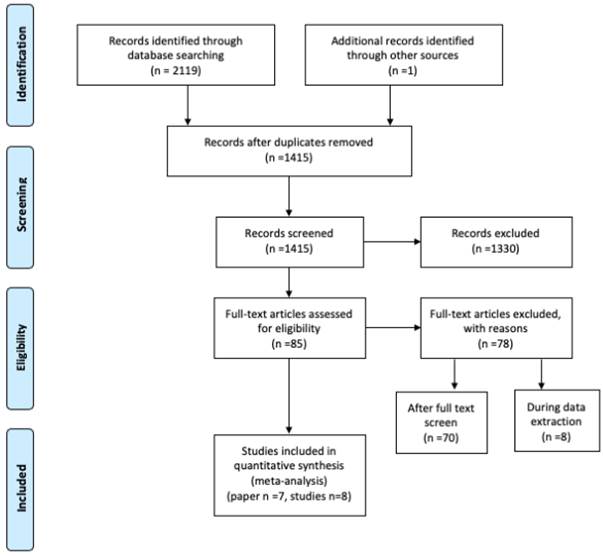
Figure 2 Summary of the study selection procedure for insecure attachments and empathy (PRISMA, 2009)
3.1. Meta-Analytic Review of Relation between Secure Attachment and Empathy
Eleven thousand five hundred forty-two participants (N=11542) were included in the meta-analytic review that studied the relations between secure attachment and empathy. The effect sizes found in this study wasr=.23(95% CI = .22, .25,Z-value = 25.03,p≤.001) for fix model and r=.22for random model (95% CI = .21, .28,Z-value = 5.94,p≤.001). Concerning Heterogeneity of studies included in this meta-analytic review was significant (I2=90.27%,Q-value=133.66, df = 13,p≤.001).The results of the Forest plot and the Funnel plot are presented in Figures 3 and 4.
3.2. Meta-Analytic Review of Relation between Avoidant Attachment and Empathy
Three thousand one hundred and fifteen participants(N= 3115) were included in the meta-analytic reviewthat studied the relations between avoidant attachment and empathy. The effect sizes found in this study wasr=−.23(95% CI =−.26,−.19,Z-value =−12.89,p≤.001) for fix model an dr=−.22for random model(95% CI =−.39,−.02,Z-value =−2.17,p=.03). The heterogeneity of studies included in this meta-analytic review was significant (I2= 96.44%,Q-value = 168.47,df = 6,p≤.001). The results of the Forest plot and the Funnel plot are presented in Figures 5 and 6.
3.3. Meta-Analytic Review of Relation between Anxious Attachment and Empathy
Three thousand four hundred and seventy-nine participants (N= 3479) were included in the meta-analytic re-view that studied the relations between anxious attachment and empathy. The effect sizes found in this study was r=−.08(95% CI =−.12,−.05,Z-value =−4.82, p≤.001) for fix model and r=−.11for random model (95% CI =−.27,.06,Z-value =−1.27,p=.021). The heterogeneity of studies included in the meta-analytic review was significant (I2= 95.59%,Q-value = 158.79,df = 7,p=<.001). The results of the Forest plot and the Funnel plot are presented in Figures 7 and 8.
4. Discussion
Because attachment style and empathy are two essential processes in the healthy development of children and adolescents, and are reflected in the social behavior during adult life, the main purpose of this study was to contribute with the clarification of the relationship between secure and insecure attachments and empathy. It is important to notice that the different dimensions of empathy and the gender of individuals are factors that have been proven to have an impact on the relation between attachment style and empathy itself. However, as it was established before, these factors were not considered for this meta-analytic review, due to lack of enough studies which included this information and their relationship with the subject hereby discussed, or because there were not enough studies that included such information and the data needed for our statistical procedure.
The results of this meta-analytic study found, as we expected, a moderated and positive relation among secure attachment and empathy, which confirms the previous findings in the literature (Delhaye et al., 2013; Khodabakhsh, 2012; Laible et al., 2004; Mikulincer et al., 2001; Murphy et al., 2015; Panfile & Laible, 2012). The secure attachment, characterized by a caregiver potentially available, supportive and worthy of acceptance (Bartholomew & Horowitz, 1991), is a stable base to develop a strong capacity to empathize with others. Our results reinforce the idea of a consistent caregiving to develop secure attachment relationships that can allow children and adolescents to securely explore the environment and generate an atmosphere where social skills and empathy can be promoted. Indeed, the security experienced and learned during childhood, and recalled during the adolescence, become in the solid foundation to establish good relationships with others during different life stages. Moreover, Khodabakhsh (2012) indicated individuals with a secure attachment style develop a sense of trust with their caregivers, who respond empathically and therefore children and adolescents imitate that capacity to respond emotionally and empathically in later relationships. In this sense, the empathy of the caregiver acts as a model for them. Furthermore, it is probable that the security and availability provided by caregivers allows children and adolescents learning to explore without fear the emotions and point of view of others, facilitating the emotional and cognitive empathic process. Furthermore, children and adolescents that perceive that they have had a secure attachment with their caregiver, have the emotional stability needed to cope with others’ negative emotions or suffering without experiencing an excessive personal distress.
As we have argued in the introduction, when the relationship of insecure attachment and empathy is studied, ambivalent empirical results are obtained. Consequently, a meta-analytical review was needed in order to distinguish the characteristics of these relationships.
Our results indicated that there is a negative relation between avoidant style of attachment and empathy. As Gross and colleagues argued, the negative relation between avoidant attachment and empathy can be explained by the internal cognitive representations (2017).
The avoidant attachment is characterized by a negative representation of the others, so this could prevent the child from being empathetic because he/she considers others as unworthy of care, or because the other could be perceived as a threat to his/her own safety. Children and adolescents that experience an avoidant attachment with their caregiver want to protect themselves and others, and this is achieved by avoiding proximity and maintaining a sense of invulnerability through independence, which leads to a lack of empathy for others. Moreover, children and adolescents that experience avoidant attachment with their caregiver can present behavioral problems due to the high physiological activation and distress, and a lack of social expressiveness and skills, which, as a result, ends in a lack of empathy (Khodabakhsh, 2012).
Concerning anxious-ambivalent attachment style, our meta-analytic study is not conclusive. We found a negative and small correlation between the anxious-ambivalent attachment style with empathy under the fixed effect model; however, this effect disappeared under the random-effects model. Borenstein and colleagues (2010) indicate the fixed-effect model attributes more weight to large sample studies, while using random-effects model, small studies gain influence. This finding supports the idea that anxious-ambivalent attachment style may be independent of the empathic process when focused on random-effects model. The ambivalence that is present in this attachment style may produce erratic and unpredictable behaviors. Individuals presenting an anxious ambivalent attachment style may have a duality on their behavior that can account for the inconsistencies mentioned before, going from high to low levels of empathy. In that sense, the inconsistencies on the findings for this attachment style may be attributed to the different dimensions of the empathy factor. In that sense, anxious-ambivalent individuals may portray high levels of empathy, because they needed to develop this characteristic due to their concern with pleasing others and to cope with their anxiety in this way. Conversely, anxious ambivalent individuals can also present low levels of empathy, because of an inherent disinterest to empathize with others due to the huge amount of anxiety they experience, which leads to being excessively focused on selfnecessities rather than the necessities of others. Moreover, the fear of being abandoned by attachment figures in anxious-ambivalent attachment reinforces their disinterest to empathize with others.
4.1. Strengths
As for the strengths of this research, it could be argued that, as a meta-analytic review, it followed a clear procedure in terms of search strategies, delimitation of the scope, inclusion/exclusion criteria, and statistical procedure. It also adds value to research about the measurement of the relationship between attachment styles and empathy by not being limited to a sample of individuals, which could add a bias in the measurement. Instead, the study hereby presented took into account several previous studies (2119 papers at the beginning) that were carefully filtered based on specific eligibility criteria. Thus, rendering a significant population of: (a) Eleven thousand five hundred forty-two participants (N = 11542) for relations between secure attachment and empathy; (b) three thousand one hundred and fifteen participants (N = 3115) for relations between avoidant attachment and empathy; and (c) three thousand four hundred and seventy-nine participants (N = 3479) for relations between anxious attachment and empathy.
Another of the strengths is that, by means of the meta-analytic review performed, it was possible to accomplish the main goal set from the start and measure the relationship between attachment styles and empathy, with the following results: (i) it was possible to observe a moderated positive relationship between empathy and the secure attachment style; (ii) it was possible to identify a negative relation between avoidant attachment and empathy; and (iii) though it was not possible to find a definite relation between the anxious attachment style and empathy, this could be explained by high levels of empathic concern (justifying the positive relation reported), but also with high levels of personal distress/low empathy (justifying the negative relation).
4.2. Limitations
One of the limitations of this study was the impossibility to analyze the relationship between attachment type and the different dimensions of empathy (cognitive and emotional), due to the lack of enough studies. Another limitation was that the relationship between attachment and empathy in specific samples should be also analyzed such as convicts, autism, etc. A significant limitation was the different attachment classifications and instruments, and the wide age range of the participants in the studies made it very difficult to compare them. Finally, the results can be limited to some cultures and countries, due to most of the studies being carried out in Asia and North America. There were little studies in other cultures, such as Latin America or Africa. Attachment style may vary from culture to culture; therefore, further studies are needed to expand these results.
Since the wide variety of attachment measures and classifications could not be merged into single types of attachment, it was decided to conduct this research taking into account only those self-report instruments related to parent or general attachment in late childhood, young adolescents, and adults. This implies that the findings in the study can only be applied to this population and attachment classification.
4.3. Implications and Future Directions
Future research will be strengthened and refined through the inclusion of observational measures during infancy. Also, for future studies, ways to include the multidirectional nature of empathy and gender as part of the study on the relations of attachment styles and empathy must be considered. Moreover, it could be interesting to study the relationship between empathy and maternal-paternal attachment separately in the future, because attachment style can vary between parents. Furthermore, the relationship between attachment and empathy from a romantic or peer perspective, during adolescence and adulthood, should be studied in future research to compare the stability of attachment patterns across the lifespan. Studies such as this one are very important in the area of psychological research and that is the reason to suggest more future studies that include more parameters (some of which were left out because of the scope and available data for our study). This, in order to better understand the relationship between such important variables and to better design trainings of empathy tailored on attachment styles.
5. Conclusion
To summarize, this meta-analytic review synthetizes the association between secure, ambivalent, and avoidant attachment styles and empathy during late childhood, adolescence and adulthood, considering self-reported instruments and attachment to parents. It was found a moderated and positive relation among secure attachment and empathy, a negative correlation with avoidant attachment and empathy and a lack of association between ambivalent attachment and empathy. These results are in accordance with a previous meta-analysis by Li et al. (2021), performed in childhood and adolescents, which would lead to the conclusion of a stability of the relationship between attachment and empathy during adulthood too.
Moreover, these findings may be the basis for future empirical research or other meta-analytic reviews on the relationship between empathy and attachment styles that include more dimensions and variables to delve deeper into the subject. For future research, it could be considered to include aspects such as: (a) including all ages (late adulthood included); (b) adding algorithms that could account for the distinct dimensions of empathy (to avoid considering as a single construct within the statistical analysis); (c) adding the variable of gender; (d) including other manifestations of attachment such as romantic relationships, or peer relationships, which would lead to a deeper understanding of the link between attachment and empathy.













